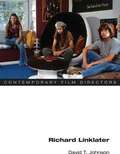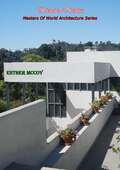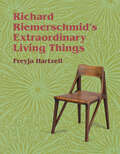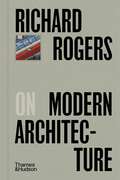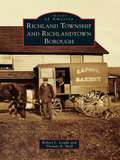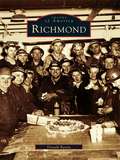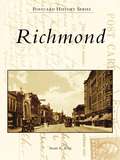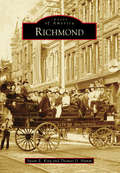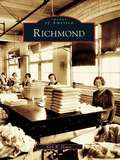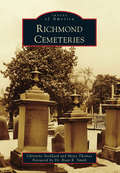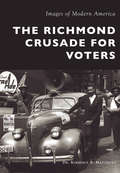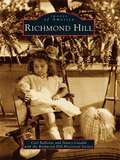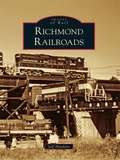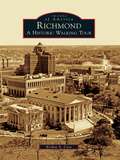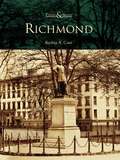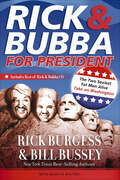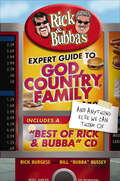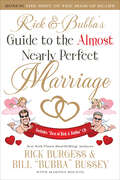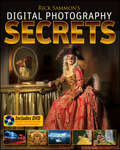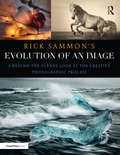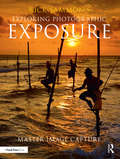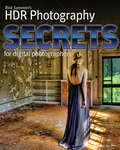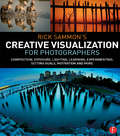- Table View
- List View
Richard Linklater (Contemporary Film Directors)
by David T. JohnsonRichard Linklater's filmmaking choices seem to defy basic patterns of authorship. From his debut with the inventive independent narrative Slacker, the Austin-based director's divergent films have included the sci-fi noir A Scanner Darkly, the socially conscious Fast Food Nation, the kid-friendly The School of Rock, the teen ensemble Dazed and Confused, and the twin romances Before Sunrise and Before Sunset. Yet throughout his varied career spanning two decades, Linklater has maintained a sense of integrity while working within a broad range of budgets, genres, and subject matters. Identifying a critical commonality among so much variation, David T. Johnson analyzes Linklater's preoccupation with the concept of time in many of his films, focusing on its many forms and aspects: the subjective experience of time and the often explicit, self-aware ways that characters discuss that experience; time and memory, and the ways that characters negotiate memory in the present; the moments of adolescence and early adulthood as crucial moments in time; the relationship between time and narrative in film; and how cinema, itself, may be becoming antiquated. While Linklater's focus on temporality often involves a celebration of the present that is not divorced from the past and future, Johnson argues that this attendance to the present also includes an ongoing critique of modern American culture. Crucially filling a gap in critical studies of this American director, the volume concludes with an interview with Linklater discussing his career.
Richard Neutra: Masters Of World Architecture Series
by Esther McCoyDiscover the visionary work and enduring legacy of one of modern architecture's most influential figures in Esther McCoy's "Richard Neutra: Masters Of World Architecture Series." This meticulously researched and richly illustrated book offers an in-depth exploration of Richard Neutra's life, philosophy, and groundbreaking contributions to 20th-century architecture.Esther McCoy, a renowned architectural historian and critic, provides a comprehensive account of Neutra's career, from his early years in Vienna to his pivotal role in shaping the architectural landscape of Southern California and beyond. Through engaging narrative and detailed analysis, McCoy highlights Neutra's innovative approach to design, characterized by his commitment to integrating nature, technology, and human needs.The book delves into Neutra's most iconic projects, including the Lovell Health House, the Kaufmann Desert House, and the Case Study Houses, showcasing his mastery of form, function, and environmental harmony. McCoy examines how Neutra's work responded to the challenges of modern living, emphasizing his use of open plans, extensive glazing, and seamless indoor-outdoor transitions to create spaces that promote health and well-being.Rich with photographs, sketches, and architectural drawings, "Richard Neutra: Masters Of World Architecture Series" provides readers with a visual feast and a deeper understanding of Neutra's design principles and aesthetic vision. McCoy also explores Neutra's collaborations with other prominent architects and his influence on subsequent generations of designers.This book is an essential read for students of architecture, practicing architects, and anyone interested in the evolution of modern design. Esther McCoy's authoritative and engaging writing brings Neutra's work to life, offering readers a comprehensive and inspiring portrait of a true master of world architecture.
Richard Riemerschmid's Extraordinary Living Things
by Freyja HartzellHow Richard Riemerschmid&’s designs of everyday—but &“extraordinary&”—objects recalibrate our understanding of modernism.At the beginning of the twentieth century, German artist Richard Riemerschmid (1868–1957) was known as a symbolist painter and, by the advent of World War I, had become an important modern architect. This, however, the first English-language book on Riemerschmid, celebrates his understudied legacy as a designer of everyday objects—furniture, tableware, clothing—that were imbued with an extraordinary sense of vitality and even personality. Freyja Hartzell makes a case for the importance of Riemerschmid's designed objects in the development of modern design—and for the power of everyday things to change the way we live our lives, understand history, and design our future. Hartzell offers for the first time an interpretive history of Riemerschmid's design practice embedded in a fresh examination of modernism told by the objects themselves. Hartzell explores Riemerschmid's early drawings, paintings, and prints; his interiors and housewares, which represent a modernist shift from exclusive image to accessible object; his designs for women's clothing; his immensely popular wooden furniture; his serially produced ceramics and their appeal to German nationalism of the period; and his complex and compelling pattern designs for textiles and wallpapers, the only part of his creative practice that spanned his entire career. Riemerschmid, Hartzell writes, was at his most inventive, playful, and free when designing things for everyday use. His uniquely designed forms allow us to recognize the utilitarian object not just as a tool but as an individual being—a thing with a soul.
Richard Rogers on Modern Architecture (Pocket Perspectives)
by Richard RogersA manifesto for the future of architectural practice e and the necessity significance of good design to in modern life, by renowned British architect Richard Rogers. Written during what architect Richard Rogers saw as a moment of crisis in modern architecture, this essay explores how the way we build—and live—could change for the better. Roger argues that poor design, monotony and inhuman scale are not the results of a lack of talent nor the failures of the Modern movement. Rather, these issues arise as a result of exploitative economic systems and businesses that put profit above people. Best known for his work on the Pompidou Centre in Paris, the European Court of Human Rights in Strasbourg, and the Lloyd's building and Millennium Dome in London, Rogers was one of the most original and inventive architect of his time. He was a frequent commentator on the contemporary scene. As a practitioner, he was in the best position possible to appreciate how economic forces can create—or frustrate—good design. A succinct summary of his design philosophies, Richard Rogers on Modern Architecture continues to be a powerful manifesto.
Richard Sopris in Early Denver: Captain, Mayor & Colorado Fifty-Niner
by Linda BjorklundFrom Gregory's Diggings prospector to Denver mayor, Richard Sopris left an indelible mark on the Mile High City and Centennial State. During an 1860 prospecting expedition, Sopris discovered Glenwood Springs and the nearly thirteen-thousand-foot summit later named for him. Following life as a steamboat captain, he was appointed captain of Company C, First Colorado Cavalry, in 1861 and commanded volunteer troops at Glorieta Pass. After serving as a delegate to the first constitutional convention of Colorado and as Arapaho County sheriff, he helped quell the Hop Alley Chinese Riot of 1880 and enacted public works projects to rid Denver of a deadly typhoid outbreak. After his mayoral term ended in 1881, Sopris became the first commissioner of his beloved City Park. Author Linda Bjorklund celebrates the unsung life and accomplishments of a founding son of Colorado.
Richland Township and Richlandtown Borough (Images of America)
by Robert L. Leight Thomas R. MollRichland Township, located in historic Bucks County, was settled around 1710 by Welsh Quakers who used European farming methods to turn the swamp into rich farmland. Prior ro the Civil War, residents played key roles in hiding the Liberty Bell, Fries Rebellion, and the Underground Railroad. The first settlement grew around the Richland Friend's Meeting House and was incorporated as Quakertown Borough in 1855. Another village, Richlandtown, was a center of religious and commercial life. Richland Township remained mainly agricultural during the first half of the 20th century, while Richlandtown, incorporated in 1890, continues to be a typical small town. The images in Richland Township and Richlandtown Borough introduce the reader to esteemed traditions in religion, education, agriculture, industry, and commerce.
Richmond
by Donald BastinSpanning from the shores of San Francisco Bay to the rolling hills of the San Pablo Ridge, Richmond is a city with a history as diverse as its citizens. From its beginnings as a part of Rancho San Pablo, Richmond has evolved through the years into a vibrant, modern city with many types of industries and communities. However, many people have never seen the Richmond of yesterday, with its massive shipbuilding operations that employed thousands of steelworkers, both men and women, during World War II. At one point in the 1940s the city's shipyards had nearly 100,000 workers turning out Liberty ships and other vessels by the score for the war effort. Richmond also boasted a Ford assembly plant, rail yards, and myriad small industries to support them.
Richmond
by Susan E. KingRichmond lies on the eastern border of the state and is the county seat of Wayne County. The earliest settlers arrived on the banks of the Whitewater River in 1806, quickly populating the area and transforming the wilderness into farmland. By the end of the century, the National Road, the rivers, and the railroads combined to make Richmond a manufacturing, commercial, architectural, and cultural center. The images found in this book document the late 19th and early 20th centuries, when Richmond was at the height of its affluence and its buildings, parks, bridges, and homes were among the finest in the state. This is also the period when postcards became a common form of quick communication and publishers produced them in great numbers. Richmond provided unlimited source material for these cards.
Richmond
by Thomas D. Hamm Susan E. KingFounded by Quakers from North Carolina more than 200 years ago, Richmond boasts a rich and colorful history. White and black migrants from older parts of the United States joined emigrants from Ireland and Germany to create a diverse, flourishing, and at times contentious community. Railroads, the Whitewater Canal, and the National Road laid the foundations for economic growth before the Civil War, and Richmond grew steadily in population and prosperity from the Civil War until the late 20th century. Local folklore claims that at one time the city had more millionaires in proportion to population than any other place in the United States. While erecting remarkable homes and buildings, founding enduring institutions like schools, churches, and museums, and supporting at one time as many as six newspapers, Richmond produced memorable and colorful characters who left their mark not just in Richmond and Indiana, but around the United States.
Richmond (Images of America)
by Kirk W. HouseThrough the centuries, Richmond soil has supported everything from forest to farms to fairways. Long ago, textile mills were strung along the waterways and more than a dozen one-room schools dotted the landscape. In Richmond, rediscover those bygone places and other cherished scenes: country churches, farm boys, mill employees, state road crews with their horses, ladies in elegant hats, small-town doctors hurrying out in early automobiles, and Richmond boys in baseball and army uniforms. Meet schoolteacher Florence Richmond, legislator Lucy Rawlings Tootel, Civil War veteran David Kenyon, historian Eleanor Smith, and clothier Chet Sherman. Explore the villages of Carolina, Usquepaugh, Tug Hollow, Arcadia, Hillsdale, Wyoming, Alton, Woodville, and Wood River Junction. These people and places make Richmond a rural treasure.
Richmond Cemeteries
by Dr Ryan Smith Christine Stoddard Misty ThomasRichmond, Virginia, the capital of the Confederacy and once one of the most prosperous cities in the United States, is home to a range of cemeteries that tell the story of American trends in honoring the dead. African slaves were interred in Shockoe Bottom's so-called "burial ground for negroes," US presidents James Monroe and John Tyler were buried in Hollywood Cemetery, and Civil War soldiers were commemorated throughout the metropolis; indeed, the River City has laid blacks and whites to rest in flood zones and on rolling hills alike. During and shortly after the Civil War, Richmond worked to accommodate thousands of new graves. Today, Richmonders work to preserve and celebrate the past while making way for the future.
Richmond Crusade for Voters, The (Images of Modern America)
by Dr Kimberly MatthewsThe Richmond Crusade for Voters, founded in 1956 to directly oppose Massive Resistance and the Stanley Plan, has served the city of Richmond for 60 years. Despite efforts to suppress minority voter turnout, the Richmond Crusade for Voters thrived at motivating voters to participate in local, state, and national elections. The organization was skilled at mobilizing African American voters, and its purpose, then and now, is to increase the voting strength of the citizens of Richmond. Images of Modern America: The Richmond Crusade for Voters provides a pictorial history of one of the nation’s most influential voter education and voter registration organizations through vintage and contemporary images.
Richmond Hill (Images of America)
by Carl Ballenas Richmond Hill Historical Society Nancy CataldiRichmond Hill evolved after the Civil War on land where orchards once blossomed and cattle once grazed. Nestled in the shadow of New York City, it is one of the city's first planned communities. The Victorian era saw the construction of Queen Anne-style mansions, and the opening of the Brooklyn Bridge in 1883 brought expansion and increased traffic. Soon, newspapers began boasting about the many parks, grassy lawns, tasteful homes, and proud residents heralding a promising future. Richmond Hill contains more than two hundred vintage photographs to illustrate the unique history of the community. The oldest eatery in Queens, the Hofbrau Restaurant, was the favorite hangout of Mae West, Babe Ruth, and many others. Baseball great Phil Rizzuto made Richmond Hill his home, as did the Marx Brothers, author Ameila Edith Barr, and photojournalist Jacob Riis. Important political events took place in Richmond Hill, such as the newly rediscovered address made in 1903 by Pres. Theodore Roosevelt, as well as cultural milestones, such as the composition of "When Irish Eyes Are Smiling" at the Hofbrau Restaurant. Richmond Hill includes these and countless other stories that make up its rich, unique history.
Richmond Railroads
by Jeff HawkinsDuring the second half of the 20th century, the railroads that operated in the Mid-Atlantic region offered a wide variety of subject matter for railroad enthusiasts and photographers to marvel at. A prime location to witness this activity was in Richmond--a railroad melting pot. As with any major city, the railroads played a significant role in Richmond's growth and development. As a result of being served by five different railroads, a labyrinth of railroad infrastructure emerged, including the Triple Crossing, a world-renowned landmark. Millions of travelers have passed through Broad Street and Main Street Stations on famous streamliner passenger trains such as the Silver Meteor and the George Washington. Images of Rail: Richmond Railroads documents the past 60 years of railroading in the Capital City, which has seen drastic changes as a result of corporate mergers, urban development, and technological advances.
Richmond: A Historic Walking Tour (Images of America)
by Keshia A. CaseImages of America: Richmond: A Historic Walking Tour guides readers through one of the earliest cities in the United States. The book offers stories about settlers and Native Americans, our Founding Fathers, and even famous celebrities such as Elvis Presley, who made a visit to the Jefferson Hotel. Presented in this book are several walking tours, including one through Capitol Square, home to the Thomas Jefferson-designed state capitol; a stroll down Monument Avenue, one of the first streets to be listed on the National Register of Historic Places; and even a ramble through Hollywood Cemetery, the picturesque 19th-century resting spot for many celebrated historical figures.
Richmond: A Historic Walking Tour (Then and Now)
by Keshia A. CaseIn addition to being the state capital, Richmond, Virginia, was also the capital of the South during the Civil War. After Reconstruction, businesses developed, and the warehouse district--Shockoe Bottom--was rebuilt, boosting Richmond's economic growth. Today Richmond is a vibrant city that embraces its historical past while looking toward future developments. Then & Now: Richmond uses late-19th-century photographs of Richmond neighborhoods, churches, businesses, and schools, contrasting these historic photographs with contemporary views of the same Richmond sites such as St. John's Church, the Capitol, Broad Street, Main Street, and the Old Stone House. Then & Now: Richmond takes a step back in time and compares the glory of the past with the progress of the future.
Rick & Bubba for President: The Two Sexiest Fat Men Alive Take on Washington
by Martha Bolton Rick Burgess Bill BusseyGet double the presidential fun with the radio hosts guaranteed to bring carbs back to the White House. Take a stand for God, country, and apple pie!Still wondering who to vote for?Well, wonder no more. In Rick & Bubba for President you’ll discover that the two self-proclaimed “Sexiest Fat Men Alive” are exactly what Washington needs. From global warming (“We’d get involved, but it’s just been so doggone hot lately.”), to updating Air Force One (“Hasn’t it gone without a pizza over long enough?”), it’s obvious that Rick and Bubba have the fresh ideas that Americans have been waiting for.Whether male or female, Republican, Democrat, Independent, or undecided, we can all agree on one thing: two heads of state have got to be better than one. So get out the White House barbeque! Rick and Bubba are headed to Washington!
Rick & Bubba's Expert Guide to God, Country, Family, and Anything Else We Can Think Of: Including a 'Best of Rick and Bubba' CD!
by Martha Bolton Rick Burgess Bill "Bubba" BusseyThe New York Times–bestselling Southern manifesto from the “delightful team [that] blends down-home humor with rock-solid truth” (Max Lucado).Rick and Bubba are two of America’s zaniest syndicated radio hosts. Now, Rick and Bubba bring their own brand of southern humor and homespun wisdom to the book world. Rick & Bubba’s Expert Guide to God, Country, Family, and Anything Else We Can Think Of is a sometimes touching, always hilarious, look at the world through Rick and Bubba’s eyes. Rick and Bubba wax eloquent on everything from little league soccer to the frustrations of getting the family ready for church on a Sunday morning, to big Southern hair.
Rick & Bubba's Guide to the Almost Nearly Perfect Marriage
by Martha Bolton Rick Burgess Bill "Bubba" BusseyThe popular radio hosts and bestselling authors share the kind of insight into matrimony you’re not likely to get anywhere else—and that’s a guarantee!Rick and Bubba are at it again, and this time it is all about marriage. Addressing such topics as apologizing (The Ten Worst Ways to Say I’m Sorry), communication (Grunting Is Not a Language), date nights (Worst Date Nights in History), finances (I Thought You Paid the Gas Bill), and playing sports together (I Did Too Let You Win), the two “sexiest fat men alive” will have couples everywhere tied in knots. With stories, top ten lists, and even a bonus addendum of their oft mentioned, “The Book of Blame,” this humorous look at marriage is long overdue. This book will revolutionize your way of looking at married life. And it might just remind you all over again why you fell in love in the first place.
Rick Sammon's Complete Guide to Digital Photography 2.0, Revised Edition
by Rick SammonThis thorough guide covers all the steps in the digital photographic process. The book teaches basic technical picture taking and the art of photography, plus introductory and advanced digital techniques.
Rick Sammon's Digital Photography Secrets
by Rick SammonLearn the tips and tricks used by a top photographer in the digital photography industry in Rick Sammon's Top Digital Photography Secrets.<P><P> Filled with beautiful photographs and the techniques Rick Sammon used to capture them, this book offers you motivation to capture stunning photographs and the tools and tricks you need to capture them. With more than 100 techniques for use behind the camera, this book will improve the camera skills of both amateur and experienced photographers. Additionally, this book includes a chapter on post-production secrets, and a Rick Sammon DVD Guide lighting, camera, and digital photography basics. In this 1-hour DVD, Rick shows you how to get great photos using a variety of lighting sources, camera-specific techniques, and basic rules of photography.
Rick Sammon's Evolution of an Image: A Behind-the-Scenes Look at the Creative Photographic Process
by Rick SammonRick Sammon’s Evolution of an Image illustrates the creative photographic process from start to finish. In this book, Canon Explorer of Light Rick Sammon pulls back the curtain to prove that creating amazing photographs is a well-thought-out process that involves several stages. Comprising 50 case studies that examine photographs taken by Rick around the world in a wide variety of shooting situations, Evolution of an Image shows the power of creative thinking, getting it right in the camera, and the careful use of image processing using Lightroom. By including his outtakes— and the reasons that he considers them outtakes— Rick suggests the steps that every photographer should take in order to improve their images. Combining technical advice with tips on lighting, composition and using Lightroom, this book will motivate and encourage those looking to evolve as creative photographers and digital darkroom artists. Key features include: • More than 200 before-and-after photographs • Fully illustrated sections on wildlife, seascape, landscape, scenic, action and people photography • Screen grabs showing Rick’s Lightroom adjustments • Suggestions on working in Adobe Photoshop Lightroom as well as Adobe Photoshop • Special section on Rick’s "Sammonisms," or quick tips on getting the best in-camera image • Advice on evolving as a photographer • Inspirational photographs from Provence, the Palouse, Kenya, Antarctica, Iceland, Alaska, Mongolia, Myanmar, Colorado and more
Rick Sammon's Exploring Photographic Exposure: Master Image Capture
by Rick SammonLight is the primary element of any photograph, but it may also be the most frustrating. Rick Sammon can help you eliminate those frustrations. With over 300 new images, Exploring Photographic Exposure takes you through the basics of exposure and how to apply them in any setting; from photographing wildlife to people, from landscapes to seascapes. Learn how to move away from the "spray and pray" approach by seeing light and applying camera settings to take fewer—and better—photos. Not just all tech talk, you’ll also learn how to explore exposure modes for more creative images, and to change and rescue exposures in post-processing. Key features include: More than 300 before-and-after images on how to apply the basics of exposure concepts to a variety of genres, including wildlife photography, landscape photography, studio photography, and everything in-between; A guide on controlling light in a photograph, and how light affects an exposure; Tips on working with composition in Adobe Photoshop Lightroom as well as Adobe Photoshop; Advice on evolving as a photographer.
Rick Sammon's HDR Secrets for Digital Photographers
by Rick SammonTop photographer Rick Sammon shares his greatest HDR tips and tricksHigh Dynamic Range (HDR) photography is a process in which a photographer shoots multiple shots of the same subject at varying exposure settings and then "stitches" the images together with photo-editing software into a single photo that presents sharper color and focus than a single image. World-renowned digital photographer and Canon Explorer of Light Rick Sammon reveals his most amazing HDR tips, tricks, and techniques for creating the best possible HDR images.Packed with more than 150 of Sammon's stunning full-color photos and more than 200 techniques, this invaluable guide inspires and motivates you to capture and edit your own unique still-life images.World-renowned digital photographer and Canon Explore of Light Rick Sammon reveals a wealth of unparalleled High Dynamic Range (HDR) tips, tricks, and techniquesInspires both amateur and experienced photographers to boost their creativity, and improve the quality of their images in the digital darkroomFeatures more than 150 beautiful images from Sammon's own portfolio as well as more than 200 tips and tricks for shooting and editing HDR imagesHDR Secrets for Digital Photographers unveils an abundance of tips and tricks that will help you make your good HDR photos great.
Rick Sammon’s Creative Visualization for Photographers: Composition, exposure, lighting, learning, experimenting, setting goals, motivation and more
by Rick SammonThe difference between seeing and looking is essential—much like the difference, in music, between hearing and listening. In Creative Visualization, master photographer, photo educator and photo instructor Rick Sammon presents his proven methodology for creative digital photography. His signature inspiring and motivating approach opens creative avenues for photographers in a variety of genres. With easy-to-follow examples, Sammon shows you how simple changes—with visualization, composition, post-processing, and more—can mean the difference between a snapshot and a great shot. This book, illustrated with more than 300 of Rick’s photographs, includes invaluable information about exposure, composition, subject choice, lighting, mood, and depth. In the Food for Thought section, Rick offers guidelines for setting goals, getting motivated, connecting with a subject, learning, painting with light, thinking like a painter and more. In Develop Your Creative Vision, Rick takes you on an exploration of composition, exposure, making images with impact, creating a mood, altering reality, and pursuing your passion. Corrective and creative image processing techniques, as well as HDR, EDR, panoramas and black-and-white imaging, are covered in the Image Processing Specialties section. Rick also shares a chapter on self-assignments – photo challenges – that you can use to expand your photographic horizons. Canon Explorer of Light and master photographer Rick Sammon shares the secrets behind learning to see photographically, to make the necessary changes that will have a noticeable impact on your photographs Includes easy-to-follow instruction for post-processing techniques in Lightroom and Photoshop. Tips for making the best HDR and EDR images are also included, as well as illustrations of how plug-ins can help photographers awaken the artist within. Uses clear, visual examples of "photo failures" photographs side-by-side with successful ones, outlining the small, but important changes—to composition, framing, exposure, etc.—that can immediately make a significant difference
